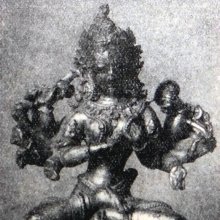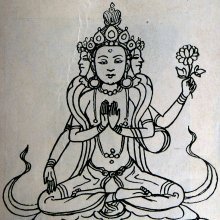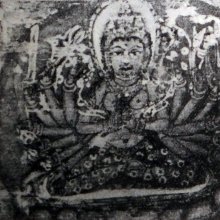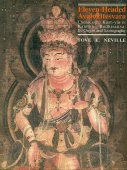Gaya, Gayā, Gayà: 33 definitions
Introduction:
Gaya means something in Buddhism, Pali, Hinduism, Sanskrit, the history of ancient India, Marathi, Jainism, Prakrit, Hindi, biology. If you want to know the exact meaning, history, etymology or English translation of this term then check out the descriptions on this page. Add your comment or reference to a book if you want to contribute to this summary article.
Alternative spellings of this word include Gaay.
Images (photo gallery)
In Hinduism
Purana and Itihasa (epic history)
Source: Wisdom Library: Bhagavata PuranaGaya (गय):—One of the sons of Sudyumna (son of Vaivasvata Manu). (see Bhāgavata Purāṇa )
Source: Wisdom Library: Varāha-purāṇaGaya (गय).—The son of Ananta, who was the son of Pṛthu, according to the Varāhapurāṇa chapter 74. Pṛthu was the son of Vibhu, whose ancestral lineage can be traced to Svāyambhuva Manu, who was created by Brahmā, who was in turn created by Nārāyaṇa, the unknowable all-pervasive primordial being. Gaya had a son named Naya.
Source: archive.org: Puranic Encyclopedia1) Gayā (गया).—A particular locality in North India (Nepal). Here there is Gaya mountain and a holy centre also. There is legend to the effect that Buddha did tapas here. People of this locality gave many presents to Yudhiṣṭhira. (Sabhā Parva, Chapter 52, Verse 16).
2) Gaya (गय).—See Gayātīrtha. General. A King of ancient India Gaya was a Rājarṣi and son of Amūrtarayas. The Rājarṣi had conducted many yajñas. A very well-known yajña of his is described in verse 18, Chapter 75 of Vana Parva. Particular Information. (1) Gaya was a member in Yamarāja’s assembly. (Sabhā Parva, Chapter 8, Verse 18).
2) He had earned reputation and wealth by visiting the sacred temples in India. (Vana Parva, Chapter 94, Verse 18).
2) The Rājarṣi had come in his vimāna (aeroplane) to witness the fighting between Arjuna and Kṛpācārya in the war, which broke out as a result of the Kauravas lifting the cows of the Virāṭa King. (Virāṭa Parva, Chapter 56, Verse 9).
2) Śrī Kṛṣṇa met Gaya on his (Kṛṣṇa's) way to Hastināpura from Dvārakā. (Udyoga Parva, Chapter 83, Verse 27).
2) Once King Māndhātā subjugated Gaya. (Droṇa Parva, Chapter 62, Verse 10).
2) Sarasvatī devī once attended a yajña conducted by Gaya, assuming for herself the name Viśālā.
2) He once gifted away land to Brahmins. (Śānti Parva, Chapter 234, Verse 25).
2) Gaya did not eat flesh. (Anuśāsana Parva, Chapter 115, Verse 59).
3) Gaya (गय).—A king born to Āyus, the son of King Purūravas by his (Āyus's) wife Svarbhānu (Svarbhānavī). This Gaya was the brother of Nahuṣa. (Ādi Parva, Chapter 65, Verse 25).
4) Gaya (गय).—An asura. (See Gayātīrtha).
5) Gaya (गय).—A King born in the dynasty of the famous emperor Pṛthu. Pṛthu had two sons called Antardhāna and Vādī. A son called Havirdhāna was born to Antardhāna by Śikhaṇḍī; he (Havirdhāna) married Dhiṣaṇā born in the family of Agni and they had six sons called Prācīnabarhis, Śukra, Gaya, Kṛṣṇa, Vraja and Ajina. (Harivaṃśa, Chapter 2, Verse 31).
6) Gaya (गय).—A King, a descendant of Dhruva. (Agni Purāṇa, Chapter 18).
Source: Cologne Digital Sanskrit Dictionaries: The Purana Index1a) Gaya (गय).—A sage who knew the power of Viṣṇu's yoga.*
- * Bhāgavata-purāṇa II. 7. 44.
1b) A son of Ulmuka and Puṣkariṇī.*
- * Bhāgavata-purāṇa IV. 13. 17.
1c) A son of Havirdhāna (Ūsu?) and Āgneyī.*
- * Bhāgavata-purāṇa IV. 24. 8: Brahmāṇḍa-purāṇa II. 36. 108: 37. 24: Vāyu-purāṇa 63. 23. Viṣṇu-purāṇa I. 14. 2.
1d) A son of Nakta and Druti: A rājaṛṣi and an aṃśa of Hari; a mahāpuruṣa who ruled his kingdom righteously and with devotion to Hari. His name is sung in an ancient gāthā, as the upholder of dharma, Vedas, Brahmaṇas and yajñas. His queen was Gāyantī who was mother of three sons Citraratha and others. At the end of his rule, he renounced the throne and sought refuge with Hari.*
- * Bhāgavata-purāṇa V. 15. 6-14: X. 60. 41: Brahmāṇḍa-purāṇa II. 14. 68: Vāyu-purāṇa 33. 57. Viṣṇu-purāṇa II. 1. 38.
1e) Though lord of seven dvīpas, he was not content. He wanted more territory.*
- * Bhāgavata-purāṇa VIII. 19. 23; XII. 3. 10.
1f) A son of (Ilā) Sudyumna and Lord of Dakṣiṇāpatha;1 king of the eastern kingdom with its capital Gaya;2 a Rājaṛṣi.3 Performed a big sacrifice and gave lavish gifts to all Brahmaṇas; even gods were pleased and granted a boon perpetuating his name by a city Gayāpuri; attained Viṣṇuloka.4
- 1) Bhāgavata-purāṇa IX. 1. 41. Matsya-purāṇa 12. 17.
- 2) Brahmāṇḍa-purāṇa III. 60. 18.
- 3) Vāyu-purāṇa 85. 19.
- 4) Vāyu-purāṇa 112. 1-6.
1g) A son of Angirasa and U7ru.*
- * Matsya-purāṇa 4. 43.
1h) A son of Balakāśva.*
- * Vāyu-purāṇa 91. 61.
2a) Gayā (गया).—A river visited by Balarāma.*
- * Bhāgavata-purāṇa X. 79. 11.
2b) (c) the kingdom of; sacred for śrāddha offering. Dharmapṛṣṭa, Brahmasaras, and Gṛdhravaṭa are chief places here; capital of Gaya; Paraśurāna performed śrāddha here.1 A pitṛtīrtha being the residence of Pitāmaha; a gāthā says that any one son may visit Gayā and satisfy all Pitṛs.2 Fit for śrāddha; a man devoted to Gayāśrāddha must dress himself in beggar's garments, circumambulate the grāma, and the next one with shaving and begging money; śrāddha in Brahmakuṇḍa and other places; going to Dharmaranya after worshipping Gadādhara; feed the Brahmans there without enquiring into their family, conduct or learning; offer piṇḍas in Gayārūpa, even for unknown cognates and names; piṇḍa for one's own self with tila; by this even heinous crimes are mitigated; a superior tīrtha; best in Makara, eclipses of the sun and moon, and Caitra and Pretapakṣa (Mahālaya); others are adhīmāsa, birthday, the evening of Guru and Śukra, the stay of Bṛhaspati in Simha which is once in twelve years.3 The face of the Veda;4 Śambhu, Viṣṇu and Ravi; sacred to Gaya.5
- 1) Matsya-purāṇa 12. 17. Brahmāṇḍa-purāṇa III. 13. 104: 19-11: 47. 17: 60. 19: Vāyu-purāṇa 85. 19.
- 2) Matsya-purāṇa 22. 4-6 and 26: 110. 2; 192. 11: 204. 8: 207. 40.
- 3) Vāyu-purāṇa 77. 97: 80. 45: 83. 12-44.
- 4) Ib. 104. 77.
- 5) Ib. 112. 20.
2c) Six in number, Gāyāgaya, Gayāditya, Gāyatrī, Gadādhara, Gayā, Gayāsura, all tending to salvation.*
- * Vāyu-purāṇa 112. 60.
Gaya (गय) is a name mentioned in the Mahābhārata (cf. II.48.15, II.82.71, XIII.116.65, XIII.115) and represents one of the many proper names used for people and places. Note: The Mahābhārata (mentioning Gaya) is a Sanskrit epic poem consisting of 100,000 ślokas (metrical verses) and is over 2000 years old.
Gaya also refers to the name of a Mountain or Tīrtha (pilgrim’s destination) mentioned in the Mahābhārata (cf. III.85.6, III.85.8).
Source: Shodhganga: The saurapurana - a critical studyGayā (गया) or Gayātīrtha is the name of a Tīrtha (holy places) mentioned in the 10th century Saurapurāṇa: one of the various Upapurāṇas depicting Śaivism.—According to the Agnipurāṇa (114.4ff) when the whole world was without any place for sacrifice, the gods went to Viṣṇu for help. Viṣṇu asked Brahmā to approach the demon named Gayā and ask for his body for performing sacrifice thereon. The gods did accordingly. Gayā offered his body to Brahmā and the gods and the latter performed sacrifice on his head and hence the name Gayā or Gayāsiras.
According to the Saurapurāṇa (67.19-21) at Gayātīrtha the feet of Śiva is established. Offering of piṇḍas to the manes here is enjoined as it is said to be very efficacious. After bathing in Mahānadī if a person touches the feet of Rudra attains Śivaloka and enjoys with the manes. A good number of Purāṇas contain the glorification of Gayā.

The Purana (पुराण, purāṇas) refers to Sanskrit literature preserving ancient India’s vast cultural history, including historical legends, religious ceremonies, various arts and sciences. The eighteen mahapuranas total over 400,000 shlokas (metrical couplets) and date to at least several centuries BCE.
Vaishnavism (Vaishava dharma)
Source: ISKCON Press: GlossaryGayā (गया).—A famous holy place on the bank of the Phalgu River in the state of Bihar, where many pilgrims go to offer worship on behalf of their forefathers. The imprint of the lotus feet of the Lord are enshrined there, and it was there that Lord Caitanya met and was initiated by Isvara Purī. Lord Buddha attained here nirvāṇa. This is one of the four places in India where many pilgrims come to offer oblations to deparated ancestors.

Vaishnava (वैष्णव, vaiṣṇava) or vaishnavism (vaiṣṇavism) represents a tradition of Hinduism worshipping Vishnu as the supreme Lord. Similar to the Shaktism and Shaivism traditions, Vaishnavism also developed as an individual movement, famous for its exposition of the dashavatara (‘ten avatars of Vishnu’).
Shaivism (Shaiva philosophy)
Source: Wisdom Library: ŚaivismGayā (गया) is a Sanskrit word referring to one of the sixty-eight places hosting a svāyambhuvaliṅga, one of the most sacred of liṅgas according to the Śaivāgamas. The presiding deity residing over the liṅga in this place (Gayā) is named Prapitāmaba. The list of sixty-eight svāyambhuvaliṅgas is found in the commentary of the Jirṇoddhāra-daśaka by Nigamajñānadeva. The word liṅga refers to a symbol used in the worship of Śiva and is used thoughout Śaiva literature, such as the sacred Āgamas.

Shaiva (शैव, śaiva) or Shaivism (śaivism) represents a tradition of Hinduism worshiping Shiva as the supreme being. Closely related to Shaktism, Shaiva literature includes a range of scriptures, including Tantras, while the root of this tradition may be traced back to the ancient Vedas.
Kavya (poetry)
Source: archive.org: Aspects of Bengal society: Ship-building and commerceGaya is the name of an ancient city mentioned by the author of the Kavikankan’s Chandikāvya pp. 195-202.—Accordingly, after the performance of the usual ceremonies before sailing, the merchant Dhanapati passed the following places: [...]—all by the side of the Ganges. Then he reached the very celebrated inland port of Bengal known as Saptagram near the Tribeni. The poet here incidentally praised this port and gave it a superiour place among the following ports and places: [e.g., Gaya, etc...]. According to the poet the merchants of the above places visit Saptagram but the merchants of Saptagram do never visit those ports and places.

Kavya (काव्य, kavya) refers to Sanskrit poetry, a popular ancient Indian tradition of literature. There have been many Sanskrit poets over the ages, hailing from ancient India and beyond. This topic includes mahakavya, or ‘epic poetry’ and natya, or ‘dramatic poetry’.
General definition (in Hinduism)
Source: archive.org: Vedic index of Names and SubjectsGaya (गय, ‘house’) is a common word in the Rigveda, and sometimes occurs later. As its sense includes the inmates as well as their belongings, it is equivalent to ‘household.’
Source: archive.org: Personal and geographical names in the Gupta inscriptions (hinduism)Gaya (गय).—In the Ṛgveda Gaya is a proper name applied to a composer of hymns. In the Atharvaveda Gaya appears to be a wonder-worder or sorcerer along with Asita and Kaśyapa who later on transformed himself into Gayāsura. According to the Vāyu-purāṇa, the city was named Gaya after an Asura, Gaya by name (Gayāsura). Viṣṇu killed this demon but granted him a boon that this city would be held highly sacred.
The Mahābhārata (III.95 and VII.64) describes the performance of sacrifices by Gaya references to which are also found in the Rāmāyaṇa (Ayodhyākāṇḍa 107), Bhāgavata-purāṇa (V.15), Brahmāṇḍa-purāṇa (chapter 34), Agni-purāṇa (chapter 107), Viṣṇu-purāṇa (IV.11), Vāmana-purāṇa (chapter 76), etc.
In Buddhism
Theravada (major branch of Buddhism)
Source: Pali Kanon: Pali Proper Names1. Gaya - A pond in which people bathed, that their sins might be washed away (J.v.388f). Buddhaghosa says (MA.i.145) it was a circular pond in which was a bathing ghat (mandavapisanthanam tittham). But see below, Gaya (2).
2. Gaya - A town in India. It lay on the road between the Bodhi tree and Benares, and was three gavutas from the Bodhi tree and fifteen yojanas from Benares. (MA.i.387f; Fa Hien says the distance from the Bodhi tree to Gaya, was twenty li, or about 3 1/3 miles). It was between the Bodhimanda and Gaya that the Buddha, on his way to Isipatana, met Upaka (Vin.i.8).
The Buddha stayed at Gaya on several occasions: once at Gayasisa (Vin.i.34; S.iv.19; A.iv.302), and also near the Tankitamanca (Sn. p.47; S.i.207, etc.), the residence of Suciloma.
Buddhaghosa says that Gaya was the name given both to the village and a bathing ghat near to it (also called Gayapokkharani). Dhamma pala (UdA.74, 75; cp. SNA.i.301), on the other hand, speaks of a Gayanadi and a Gayapokkharani as being two distinct bathing ghats, both commonly called Gayatittha, and both considered to possess the power of washing away sins. People went there, offered sacrifices to the gods, recited the Vedas, and immersed themselves in the water.
Elsewhere (ThagA.i.388f, 418; Thag.v.287) it is stated that every year, in the earlier half of the month of Phagguna (March), people held a bathing festival at the bathing ghat at Gaya, the festival being called Gayaphagguni. It was at one of these festivals that Senaka Thera was converted by the Buddha. This explanation of Gayaphaggu is, perhaps, not quite correct, for, according to some, the river (Neranjara) which ran by Gaya was itself called Phaggu (Skt. Phaggu). E.g., Cunningham: AGI.524; Bothlinck and Roths Dict. s.v. Phalgu; Neumann (Majh. N. Trans.i.271) says that the village of Gaya itself was called Phaggu.
The town of Gaya is often called Brahmagaya to distinguish it from Buddhagaya (q.v.).
Theravāda is a major branch of Buddhism having the the Pali canon (tipitaka) as their canonical literature, which includes the vinaya-pitaka (monastic rules), the sutta-pitaka (Buddhist sermons) and the abhidhamma-pitaka (philosophy and psychology).
Mahayana (major branch of Buddhism)
Source: archive.org: Bulletin of the French School of the Far East (volume 5)Gayā (गया) [?] (in Chinese: Kia-ye) is the name of an ancient kingdom associated with Rohiṇī or Rohiṇīnakṣatra, as mentioned in chapter 18 of the Candragarbha: the 55th section of the Mahāsaṃnipāta-sūtra, a large compilation of Sūtras (texts) in Mahāyāna Buddhism partly available in Sanskrit, Tibetan and Chinese.—Chapter 18 deals with geographical astrology and, in conversation with Brahmarāja and others, Buddha explains how he entrusts the Nakṣatras [e.g., Rohiṇī] with a group of kingdoms [e.g., Gayā] for the sake of protection and prosperity.

Mahayana (महायान, mahāyāna) is a major branch of Buddhism focusing on the path of a Bodhisattva (spiritual aspirants/ enlightened beings). Extant literature is vast and primarely composed in the Sanskrit language. There are many sūtras of which some of the earliest are the various Prajñāpāramitā sūtras.
General definition (in Buddhism)
Source: Wisdom Library: BuddhismGaya refers to one of the places visited by Dharmapāla during his tour of North India. Anāgārika Dharmapāla (born 1864) was a Ceylonese Buddhist who travelled across India and beyond, spreading Buddhism. According to Bhikkhu Sangharakshita in his Biographical Sketc, “he travelled as a pilgrim, not caring at all for comforts, mixing with the sanyasins, ascetics, Hindu pilgrims, and with passengers of the third and intermediate classes, eating at times the poorest food, sleeping at times in places where the poor sleep and gaining an insight into the characteristics of the poor classes, who are suffering from intense ignorance, superstition and poverty”.
Source: archive.org: Personal and geographical names in the Gupta inscriptions (buddhism)Gaya (गय).—Aśvaghoṣa’s Buddhacarita XII.87-88 (1st century A.D.) speaks of the Buddha’s visit to the hermitage called “the city of the royal sage Gaya”, who was later conceived as a great giant (see Vāyu-purāṇa chapter 105 ff.).
Source: eBooks@Adelaide: A Record of Buddhistic KingdomsGaya, a city of Magadha, was north-west of the present Gayah (lat. 24d 47s N., lon. 85d 1s E). It was here that Sakyamuni lived for seven years, after quitting his family, until he attained to Buddhaship. The place is still frequented by pilgrims. E. H., p. 41.
India history and geography
Source: archive.org: Personal and geographical names in the Gupta inscriptionsGayā (गया) or Gayāviṣaya is a place name ending in viṣaya mentioned in the Gupta inscriptions. The Gupta empire (r. 3rd-century CE), founded by Śrī Gupta, covered much of ancient India and embraced the Dharmic religions such as Hinduism, Buddhism and Jainism. Gayā is at present headquarters of the Gayā district, 60 miles due south of Patna. It comprises the modern town of Sahebganj on the northern side and the ancient town of Gayā on the southern side.
We can find evidence of the importance of Gayā growing in the period subsequent to A.D. 750. At Gayā while we have only one inscription belonging to the Gupta period, we get numerous inscriptions belonging to the Pāla period. Gayā which was the headquarters of Buddhist faith passed to the Hindus between the second and fourth centuries by A.D. 637 when Hiuen Tsang visited the city it had become a thriving centre of Hindu Brahmanical religion.
Source: Ancient Buddhist Texts: Geography of Early BuddhismGayā (गया) is the name of an ancient locality situated in Majjhimadesa (Middle Country) of ancient India, as recorded in the Pāli Buddhist texts (detailing the geography of ancient India as it was known in to Early Buddhism).—In the Sutta Nipāta we are told that once the Buddha dwelt at Gayā. The Yakkha Suciloma, it is said, threatened to harm the Blessed One, if he could not answer his questions. The Buddha said, in repay to the questions asked, that all passions proceeded from the body.
Gayā comprises the modern town of Shahebganj on the northern side and the ancient town of Gayā on the southern side. Buddhagayā is six miles to the south of Gayā.

The history of India traces the identification of countries, villages, towns and other regions of India, as well as mythology, zoology, royal dynasties, rulers, tribes, local festivities and traditions and regional languages. Ancient India enjoyed religious freedom and encourages the path of Dharma, a concept common to Buddhism, Hinduism, and Jainism.
Biology (plants and animals)
Source: Google Books: CRC World Dictionary (Regional names)Gaya in Nigeria is the name of a plant defined with Senna occidentalis in various botanical sources. This page contains potential references in Ayurveda, modern medicine, and other folk traditions or local practices It has the synonym Cassia macradenia Collad. (among others).
Example references for further research on medicinal uses or toxicity (see latin names for full list):
· Journal of Ethnopharmacology (1992)
· Flora de Filipinas, ed. 3 (1877)
· Journal of Ethnopharmacology (1987)
· Denkschriften der Koeniglich-Baierischen Botanischen Gesellschaft in Regensburg (1822)
· Synopseos Plantarum (1805)
· Sylva Telluriana (1838)
If you are looking for specific details regarding Gaya, for example side effects, chemical composition, pregnancy safety, health benefits, extract dosage, diet and recipes, have a look at these references.

This sections includes definitions from the five kingdoms of living things: Animals, Plants, Fungi, Protists and Monera. It will include both the official binomial nomenclature (scientific names usually in Latin) as well as regional spellings and variants.
Languages of India and abroad
Marathi-English dictionary
Source: DDSA: The Molesworth Marathi and English Dictionarygaya (गय).—& compounds, gayagōḷā &c. See under gaī.
--- OR ---
gayā (गया).—f (S) The name of a city in Bahar, a place of pilgrimage.
--- OR ---
gāya (गाय).—f (gau S) A cow. Pr. gāyīnēṃ gāya phaḷata nāhīṃ One poor wretch cannot help another. 2 fig. A soft or mild man. 3 The name of a black sort of beetle. 4 See explained under pārī. 5 A small colocynth. Note. gāyī the plural is, with some, singular, A cow. gāya gōvaṇēṃ g. of s. To have given one's daughter into marriage in an objectionable place. gāya cikhalānta aḍakaṇēṃ g. of s. To be fixed fast in some difficulty, trouble, or adversity. gāya māya sārakhī Cow and mother are one (i. e. as respects their milk-giving or milk). gāya hōṇēṃ To become very humble or mild (as through misfortunes or sickness). gāyīcā khūra tikhaṭa God avenges the feeble. Answering to or to gāyīnēṃ māṇīka giḷaṇēṃ Used where a loss incurred is irreparable but through incurring a greater loss or perpetrating a sin. gāyī pāṇyāvara āṇaṇēṃ or yēṇēṃ To fall a blubbering. gāyīvāsarācī tāḍātōḍa karaṇēṃ To separate near relations or break up intimate connections. gāyīvāsarācī bhēṭa karaṇēṃ To bring together close relations or loving friends. gāyīsārakhā hambāraḍā phōḍaṇēṃ To bellow outrageously--a child &c.
Source: DDSA: The Aryabhusan school dictionary, Marathi-Englishgāya (गाय).—f A cow. Fig. A soft or mild man. The name of a black sort of beetle. gāya hōṇēṃ Become very humble or mild (as through misfortunes or sickness). gāyīsārakhā hambaraḍā phōḍaṇēṃ Bellow outrageous- ly. gāya gōvaṇēṃ To have given one's daughter into marriage in an objec- tionable place. gāya cikhalānta aḍakaṇēṃ To be fixed fast in some difficulty, trouble or adversity. gāyīcā khūra tikhaṭa God avenges the feeble. gāyīnēṃ māṇika giḷaṇēṃ Used where a loss incurred is irrepar- able but through incurring a greater loss or perpetrating a sin. gāyīvāsarācī tāḍātōḍa karaṇēṃ To separate near relations or break up intimate connections.
Marathi is an Indo-European language having over 70 million native speakers people in (predominantly) Maharashtra India. Marathi, like many other Indo-Aryan languages, evolved from early forms of Prakrit, which itself is a subset of Sanskrit, one of the most ancient languages of the world.
Sanskrit dictionary
Source: DDSA: The practical Sanskrit-English dictionaryGaya (गय).—
1) Name of the people living round Gayā and the district inhabited by them.
2) Name of an Asura.
3) Wealth.
4) House, household, family.
5) Offspring, progeny.
6) The sky.
7) One's own place or abode.
-yā Name of a city in Behar which is a place of pilgrimage.
Derivable forms: gayaḥ (गयः).
--- OR ---
Gāya (गाय).—[gai bhāve ghañ] Singing, a song; यथाविधानेन पठन् सामगायमविच्युतम् (yathāvidhānena paṭhan sāmagāyamavicyutam) Y.3.112; Bhāgavata 1.9.26.
Derivable forms: gāyaḥ (गायः).
--- OR ---
Gāya (गाय).—A song; यथाविधानेन पठन् सामगायमविच्युतम् (yathāvidhānena paṭhan sāmagāyamavicyutam) Y.3.112.
Derivable forms: gāyaḥ (गायः).
Source: Cologne Digital Sanskrit Dictionaries: Shabda-Sagara Sanskrit-English DictionaryGaya (गय).—m.
(-yaḥ) 1. A species of ox, the Gayal or Bos Gavœus. 2. The name of a royal or military saint. 3. The name of an Asura. 4. One of the monkey chiefs of the Ramayana. f.
(-yā) Gaya, a city in Behar still so called, and a place of pilgrimage; the capital of the saint of the same name; it was made holy by the benediction of Vishnu, who granted its sancity to the piety of Gaya the Rajarshi; or according to another legend to Gaya the Asura, who was overwhelmed here by the deities with rocks; sacrifices should be offered onceat least in the life of every Hindu to his progenitors at Gaya. E. gai to sing, ḍaya aff.
Source: Cologne Digital Sanskrit Dictionaries: Benfey Sanskrit-English DictionaryGaya (गय).—I. m. 1. The name of a Ṛṣi, [Rāmāyaṇa] 2, 107, 11. 2. pl. The name of a people, Mahābhārata 2, 1827. 3. The name of a mountain, Mahābhārata 3, 8304. Ii. f. yā. 1. The name of a river, Mahābhārata 3, 8075. 2. The name of a river, Mahābhārata 1, 7818.
--- OR ---
Gāya (गाय).—i. e. gai + a, n. A song, [Yājñavalkya, (ed. Stenzler.)] 3, 112. In uttama-, adj. [Bhāgavata-Purāṇa, (ed. Burnouf.)] 3, 12, 21, and uru-, adj. 2, 3, 20, perhaps gā + a, Walking, or praise.
Source: Cologne Digital Sanskrit Dictionaries: Cappeller Sanskrit-English DictionaryGaya (गय).—[masculine] house, household, family, [Name] of a Ṛṣi etc., [plural] [Name] of a people. [feminine] gayā [Name] of a famous place of pilgrimage.
--- OR ---
Gāya (गाय).—1. [adjective] moving (only —°).
--- OR ---
Gāya (गाय).—2. [masculine] song.
--- OR ---
Gāya (गाय).—3. [adjective] belonging to or coming from Gaya.
Source: Cologne Digital Sanskrit Dictionaries: Monier-Williams Sanskrit-English Dictionary1) Gaya (गय):—m. ([gana] vṛṣādi; √ji cf. śaṃgaya) ‘what has been conquered or acquired’, a house, household, family, goods and chattels, contents of a house, property, wealth, [Ṛg-veda; Atharva-veda]
2) a species of ox (the Gayal or Bos gavaeus), [cf. Lexicographers, esp. such as amarasiṃha, halāyudha, hemacandra, etc.]
3) Name of a Ṛṣi (son of Plati), [Ṛg-veda x, 63, 17 and 64, 16; Aitareya-brāhmaṇa v, 2, 12]
4) (said to know charms), [Atharva-veda i, 14, 4]
5) (descendant of Atri and author of [Ṛg-veda v, 9 and 10]), [Ṛgveda-anukramaṇikā]
6) Name of a Rājarṣi (performer of a celebrated sacrifice, [Mahābhārata i, iii, iv, ix, xiii; Rāmāyaṇa ii]; he was conquered by Māndhātṛ, [Mahābhārata vii, 2281])
7) of a son (of Amūrta-rajas, [iii, vii, xii]; of Āyus, [i, 3150]; of a Manu, [Harivaṃśa 870; Bhāgavata-purāṇa ii]; of Havir-dhāna by Dhiṣaṇā, [Harivaṃśa 83; Bhāgavata-purāṇa iv]; of Ūru by Āgneyī, [Harivaṃśa 73]; of Vitatha, [1732]; of Sudyumna, [631; Bhāgavata-purāṇa ix, 1, 41]; of Nakta by Druti, [v, 15, 5])
8) Name of an Asura (slain by Śiva cf. [Religious Thought and Life in India p.87], and who like the Rājarṣi Gaya is connected with the town Gayā), [Vāyu-purāṇa ii, 44]
9) of one of Rāma’s monkey followers, [Mahābhārata iii, 16271; Rāmāyaṇa iv, vi]
10) (= -śiras) of a mountain near Gayā, [Mahābhārata iii, 8304]
11) m. [plural] the vital airs (used only for the [etymology] of gāyatrī), [Śatapatha-brāhmaṇa xiv, 8, 15, 7]
12) m. Name of a people living round Gayā and of the district inhabited by them, [Mahābhārata ii, ix; Rāmāyaṇa ii]
13) Gayā (गया):—[from gaya] a f. ([gana] varaṇādi) the city Gayā (famous place of pilgrimage in Behar and residence of the saint Gaya; cf. [Religious Thought and Life in India p.309]; sanctified by Viṣṇu as a tribute to the piety of Gaya, the Rājarṣi, or (according to another legend) to Gaya, the Asura, who was overwhelmed here with rocks by the gods; the Śrāddha should be performed once at least in the life of every Hindū to his progenitors at Gayā), [Yājñavalkya i, 260; Mahābhārata etc.]
14) [v.s. ...] cf. buddha-g
15) [v.s. ...] Name of a river, [i, 7818].
16) [from gaya] b f. of ya q.v.
17) Gāya (गाय):—[from gā] 1. gāya See uru-g.
18) [from gā] 2. gāya n. ‘a song’ See uttama-, sāma-.
19) a 1. and 2. gāya. See √1. gā and 3. gā.
20) b 3. gāya, mfn. relating to Gaya, [Aitareya-brāhmaṇa v, 2, 12.]
Source: Cologne Digital Sanskrit Dictionaries: Yates Sanskrit-English DictionaryGaya (गय):—(yaḥ) 1. m. A species of ox; name of a sage. (yā) f. The city Gayā.
Source: DDSA: Paia-sadda-mahannavo; a comprehensive Prakrit Hindi dictionary (S)Gayā (गया) in the Sanskrit language is related to the Prakrit word: Gayā.
[Sanskrit to German]
Sanskrit, also spelled संस्कृतम् (saṃskṛtam), is an ancient language of India commonly seen as the grandmother of the Indo-European language family (even English!). Closely allied with Prakrit and Pali, Sanskrit is more exhaustive in both grammar and terms and has the most extensive collection of literature in the world, greatly surpassing its sister-languages Greek and Latin.
Hindi dictionary
Source: DDSA: A practical Hindi-English dictionary1) Gayā (गया):—(v) went—past participle form of the verb '[jānā'; —gujarā bītā] good for nothing, inferior, insignificant.
2) Gāya (गाय) [Also spelled gaay]:—(nf) a cow; (a) meek and humble, harmless; —[marī khara kaune kāma] a day after the fair, to kiss the hare’s foot.
...
Prakrit-English dictionary
Source: DDSA: Paia-sadda-mahannavo; a comprehensive Prakrit Hindi dictionary1) Gaya (गय) in the Prakrit language is related to the Sanskrit word: Gata.
2) Gaya (गय) also relates to the Sanskrit word: Gaja.
3) Gaya (गय) also relates to the Sanskrit word: Gada.
4) Gayā (गया) also relates to the Sanskrit word: Gadā.
5) Gayā (गया) also relates to the Sanskrit word: Gadā.
6) Gayā (गया) also relates to the Sanskrit word: Gayā.
Prakrit is an ancient language closely associated with both Pali and Sanskrit. Jain literature is often composed in this language or sub-dialects, such as the Agamas and their commentaries which are written in Ardhamagadhi and Maharashtri Prakrit. The earliest extant texts can be dated to as early as the 4th century BCE although core portions might be older.
Kannada-English dictionary
Source: Alar: Kannada-English corpusGaya (ಗಯ):—
1) [noun] a building for human beings to live in; a house.
2) [noun] (collectively) the affairs connected with one’s home; household; family matter.
3) [noun] one’s own house.
4) [noun] much money or property; wealth.
5) [noun] a descendant or descendants collectively; progeny.
6) [noun] the sky.
--- OR ---
Gaya (ಗಯ):—[noun] a kind of bird.
--- OR ---
Gayā (ಗಯಾ):—[noun] = ಗಯೆ [gaye].
--- OR ---
Gāya (ಗಾಯ):—
1) [noun] an injury done to living tissue by a cut or blow etc., esp. beyond the cutting or piercing of the skin; a wound.
2) [noun] a pain inflicted on a person’s feelings.
3) [noun] an injury to a plant caused by cutting, scraping or other external force4) [noun] ಗಾಯಕ್ಕೆ ಉಪ್ಪು ಹಚ್ಚು [gayakke uppu haccu] gāyakke uppu haccu (prov.) to aggravate another’s agony; to make worse; ಗಾಯದ ಮೇಲೆ ಬರೆ ಎಳೆ [gayada mele bare ele] gāyada mēle bare eḷe (prov.) to hurt the feelings or add to the miseries, of the one who is offended or distressed already.
Kannada is a Dravidian language (as opposed to the Indo-European language family) mainly spoken in the southwestern region of India.
See also (Relevant definitions)
Starts with (+201): Gaya babul, Gaya eba, Gaya Kassapa, Gaya Phaggu, Gaya Sutta, Gaya-mari, Gaya-mukta, Gayab, Gayaba, Gayabas, Gayacala, Gayada, Gayadada, Gayadasa, Gayadasanibandha, Gayaderi, Gayadina, Gayaditya, Gayadoppalu, Gayaduma.
Ends with (+151): Abbhagaya, Abbhuggaya, Abbhuggaya, Abbhuvagaya, Abhigaya, Abhisamannagaya, Abhogaya, Agaya, Ahamahamigaya, Ahigaya, Ahigaya, Aigaya, Aigaya, Aka-hige-gaya, Alelgaya, Allaci Gaya, Allaci-gaya, Amtagaya, Anagaya, Anahigaya.
Full-text (+382): Gayashiras, Gayashirsha, Buddhagaya, Pretashila, Gayashikhara, Shadgaya, Gayakupa, Gayas, Pitritirtha, Druti, Gaya eba, Sphana, Sudyumna, Gayashirshaparvata, Gayadasa, Gayatirtha, Gayamahatmya, Gayasadhana, Gayasadina, Gayanti.
Relevant text
Search found 142 books and stories containing Gaya, Gayā, Gayà, Gāya; (plurals include: Gayas, Gayās, Gayàs, Gāyas). You can also click to the full overview containing English textual excerpts. Below are direct links for the most relevant articles:
Garga Samhita (English) (by Danavir Goswami)
Verses 1.18.4-5 < [Chapter 18 - Vision of the Universal Form]
Verse 5.1.30 < [Chapter 1 - Advice to Kaṃsa]
Verse 8.13.59 < [Chapter 13 - A Thousand Names of Lord Balarāma]
Rig Veda (translation and commentary) (by H. H. Wilson)
Brihad Bhagavatamrita (commentary) (by Śrī Śrīmad Bhaktivedānta Nārāyana Gosvāmī Mahārāja)
Verse 1.6.29-30 < [Chapter 6 - Priyatama (the most beloved devotees)]
Verse 1.6.27 < [Chapter 6 - Priyatama (the most beloved devotees)]
Chaitanya Bhagavata (by Bhumipati Dāsa)
Verse 1.17.79 < [Chapter 17 - The Lord’s Travel to Gayā]
Verse 3.1.71 < [Chapter 1 - Meeting Again at the House of Śrī Advaita Ācārya]
Introduction to chapter 17 < [Chapter 17 - The Lord’s Travel to Gayā]
Puranic encyclopaedia (by Vettam Mani)
Rivers in Ancient India (study) (by Archana Sarma)
8. The river Gomatī in the Purāṇas < [Chapter 5 - Rivers in the Purāṇic Literature]
10. Various other rivers in the Purāṇas < [Chapter 5 - Rivers in the Purāṇic Literature]
Related products







